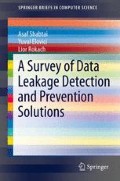Abstract
According to the Forrester Wave report [Raschke, 2008], most early DLP solutions focused on finding sensitive data as they left the organizational network by monitoring data-in-motion at the various network egress points. In the second stage, as removable storage devices (e.g., USB sticks, external hard drives) proliferated, DLP solutions began to focus on detecting data leakage at the endpoint and on providing capabilities, for example, to subvert copying of sensitive information to USB devices or CD/DVDs even if the endpoint is not connected to the network.
Access this chapter
Tax calculation will be finalised at checkout
Purchases are for personal use only
Notes
References
Byers, S. 2004. Information leakage caused by hidden data in published documents. IEEE Security and Privacy, 2(2), 23–27.
Caputo D.D., Stephens G.D., and Maloof M.A. 2009. Detecting insider theft of trade secrets. IEEE Security and Privacy, 7(6), 14–21.
Carvalho, V.R., and Cohen, W. 2007. Preventing information leaks in email. Proceedings, SIAM International Conference on Data Mining.
Cohen, W.W. 1996. Learning rules that classify e-mail. Proceedings, AAAI Symposium on Machine Learning in Information Access, 18–25.
Forte, D. 2009. Do encrypted disks spell the end of forensics? Computer Fraud and Security, 2009(2), 18–20.
Frost & Sullivan. 2008. World Data Leakage Prevention Market. Technical Report ND34D-74, Frost & Sullivan, United States.
Hong, J., Kim, J., and Cho, J. 2010. The trend of the security research for the insider cyber threat. International Journal of Future Generation Communication and Networking, 3(2), 31–40.
Hovold, J. 2005. Naive Bayes span filtering using word-position-based attributes. Proceedings, 2nd Conference on Email and Anti-Spam.
Kamra, A., Terzi, E., Evimaria, and Bertino, E. 2008. Detecting anomalous access patterns in relational databases. International Journal on Very Large Databases, 17(5), 1063–1077.
Lawton, G. 2008. New technology prevents data leakage. Computer, 41(9), 14–17.
Mun, H., Han, K., Yeun, C.Y., and Kim, K. 2008. Yet another intrusion detection system against Insider Attacks. Proceesings, Symposium on Cryptography and Information Security.
Parno, B., McCune, J.M., Wendlandt, D., Andersen, D.G., and Perrig, A. 2009. CLAMP: practical prevention of large-scale data leaks. Proceedings, IEEE Symposium on Security and Privacy.
Raschke, T. 2008. The Forrester Wave™: Data Leak Prevention, Q2 2008. Technical report, Forrester Research, Inc.
Rennie, J. 2000. ifile: an application of machine learning to e-mail filtering. Proceedings, KDD-Workshop on Text Mining.
Salem, B.M., Heshkop, S., and Stolfo, S.J. 2008. A survey of insider attack detection eesearch. Insider Attack and Cyber Security- Beyond the Hacker, Springer, 39, 23–27.
Spitzner, L. 2003. Honeypots: catching the insider threat. Proceedings, 19th Annual Computer Security Applications Conference (ACSAC’03), 170–179.
Storey, D. 2009. Catching flies with honey tokens. Network Security, 2009(11), 15–18.
Valli, C. 2005. Honeypot technologies and their applicability as a strategic internal countermeasure. International Journal of Information and Computer Security, 1(4), 30–436.
White, J. 2010. Creating personally identifiable honeytokens. Innovations and Advances in Computer Sciences and Engineering, 227–232.
White, J., and Panda, B. 2010. Insider threat discovery using automatic detection of mission critical data based on content. Proceedings, Sixth International Conference on Information Assurance and Security (IAS), IEEE, pp. 56–61.
Yixiang, S., Tao, P., and Minghua, J. 2007. Secure multiple XML documents publishing without information leakage. Proceedings, International Conference on Convergence Information Technology, 2114–2119.
Author information
Authors and Affiliations
Rights and permissions
Copyright information
© 2012 The Author(s)
About this chapter
Cite this chapter
Shabtai, A., Elovici, Y., Rokach, L. (2012). Data Leakage Detection/Prevention Solutions. In: A Survey of Data Leakage Detection and Prevention Solutions. SpringerBriefs in Computer Science. Springer, Boston, MA. https://doi.org/10.1007/978-1-4614-2053-8_4
Download citation
DOI: https://doi.org/10.1007/978-1-4614-2053-8_4
Published:
Publisher Name: Springer, Boston, MA
Print ISBN: 978-1-4614-2052-1
Online ISBN: 978-1-4614-2053-8
eBook Packages: Computer ScienceComputer Science (R0)

